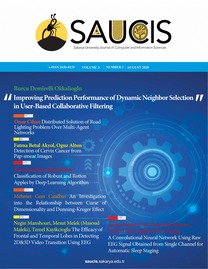Performance Assessment of a Turn Around Ranging in Communication Satellite Orbit Determination
___
[1] M. Possner, F. F. Martinez , A. Agueda Mate, , G. Garcia, , C. N.Ping Choon, , W. Hasnibi, “Operational and performance aspects of a turn-around tracking system,” In SpaceOps 2010 Conference Delivering on the Dream Hosted by NASA Marshall Space Flight Center and Organized by AIAA, pp. 2374, 2010.[2] O. Montenbruck, E. Gill, , F. Lutze, “Satellite orbits: models, methods, and applications,” Appl. Mech. Rev., 55(2), B27-B28, pp. 193-222, 2002.
[3] Soop, E. M.., “Angular tracking for geostationary orbits,” IFAC Proceedings, Volumes: 27, pp.181-186., 1994.
[4] I. Oz, , U. C. Yilmaz , “Determination of Coverage Oscillation for Inclined Communication Satellite,” Sakarya Üniversitesi Fen Bilimleri Enstitüsü Dergisi, 24(5), pp. 963-973, 2020.
[5] G. Bury, K. Sośnica, R. Zajdel, “Multi-GNSS orbit determination using satellite laser ranging,” Journal of Geodesy, 93(12), pp.2447-2463, 2019.
[6] Z. Qin, , G. Huang, Q.Zhang, L. Wang, X. Yan, , S. Xie, X. Wang, “Precise Orbit Determination for BeiDou GEO/IGSO Satellites during Orbit Maneuvering with Pseudo-Stochastic Pulses,” Remote Sensing, 11(21), 2587, 2019.
[7] Y. Gao, Z.You, , B. Xu, “Integrated Design of Autonomous Orbit Determination and Orbit Control for GEO Satellite Based on Neural Network,” International Journal of Aerospace Engineering, 2020.
[8] M. Li, J. Geng, C. Shi, Q. Zhao, “Orbit determination of geostationary satellite during maneuvers,” In International Conference on Earth Observation Data Processing and Analysis (ICEODPA), vol. 7285, pp. 728520, 2008.
[9] A. Águeda Maté, L. Strippoli, , J. Cuesta Cabanás, F. Martínez Fadrique, “SEGORD: Sequential Orbit Determination Tool for Geostationary Satellites Operations,”, In SpaceOps 2008 Conference, pp. 3206, 2008.
[10] M. Ibrahim, M. Zahara, A.Emam, M. A. Elghany, “Evaluation of Orbit Determination Using Dual Ranging Method,” In WSEAS International Conferences, 2007.
[11] I. Oz, “Evaluation of station location for orbit determination of geo satellites at different slots,” In 2017 8th International Conference on Recent Advances in Space Technologies (RAST), IEEE, pp. 375-379, 2017.
[12] H. D. Curtis, Orbital mechanics for engineering students. Butterworth-Heinemann., pp. 193- 254, 2013.
[13] M. Possner, F. Martinez Fadrique, A. Agueda Mate, G. Garcia, C. N. Ping Choon, W. Hasnibi, “Operational and performance aspects of a turn-around tracking system,” In SpaceOps 2010 Conference Delivering on the Dream Hosted by NASA Marshall Space Flight Center and Organized by AIAA, pp. 2374), 2010.
[14] C. Hajiyev, M. Ata, , “Error analysis of orbit determination for the geostationary satellite with single station antenna tracking data,” Positioning, vol:2(4), pp.135-144, 2011.
[15] Y. Hwang, B. S. Lee, H. Y. Kim, H. Kim, and J. Kim “Orbit determination accuracy improvement for geostationary satellite with single station antenna tracking data”, ETRI journal, 30(6), pp.774-782., 2008.
[16] M. Ibrahim, A. M. Abd El-Hameed, Z. Liang, H. Xingwei, “Analytical investigation for the satellite ranging data of changchun-SLR station”, NRIAG Journal of Astronomy and Geophysics, 9(1), 321-329, 2020.
[17] Y. Lv, T. Geng, Q. Zhao, X. Xie, F. Zhang, and X. Wang, “Evaluation of BDS-3 Orbit Determination Strategies Using Ground-Tracking and Inter-Satellite Link Observation”, Remote Sensing, 12(16), 2647, 2020.
[18] W. Wang, X. Yang, W. Li, Y. Ge, L. Chen, F. Cao, P. Wei, P. Liu and Z. Li, “Research on Evaluation Method of Time Transfer Performance Between Ground Stations in Two-Way Satellite Comparison Network”, IEEE Access, 9, 14038-14047, 2021.
[19] D. Vallado, “Orbit determination using ODTK version 6,” European Space Astronomy Centre (ESA/ESAC), Madrid, 2010.
- ISSN: 2636-8129
- Yayın Aralığı: Yılda 3 Sayı
- Başlangıç: 2018
Performance Evaluation of MANET Routing Protocols AODV and DSDV Using NS2 Simulator
Amenah Sufyan MHMOOD THABER, Ahmet ZENGİN
Deep Learning Methods for Autism Spectrum Disorder Diagnosis Based on fMRI Images
Muhammed Ali BAYRAM, İlyas ÖZER, Feyzullah TEMURTAŞ
A V-Model Software Development Application for Sustainable and Smart Campus Analytics Domain
ONUR DOĞAN, Semih BİTİM, Abdulkadir HIZIROĞLU
Effect of the Chaotic Crossover Operator on Breeding Swarms Algorithm
Hüseyin DEMİRCİ, Nilüfer YURTAY
Halil İbrahim CEBECİ, Yasemin KORKUT
A Conjoint Analysis of Propellant Budget and Maneuver Life for a Communication Satellite
A Study on the Efficacy of Deep Reinforcement Learning for Intrusion Detection
Halim Görkem GÜLMEZ, Pelin ANGİN
Deep Neural Networks Based on Transfer Learning Approaches to Classification of Gun and Knife Images
